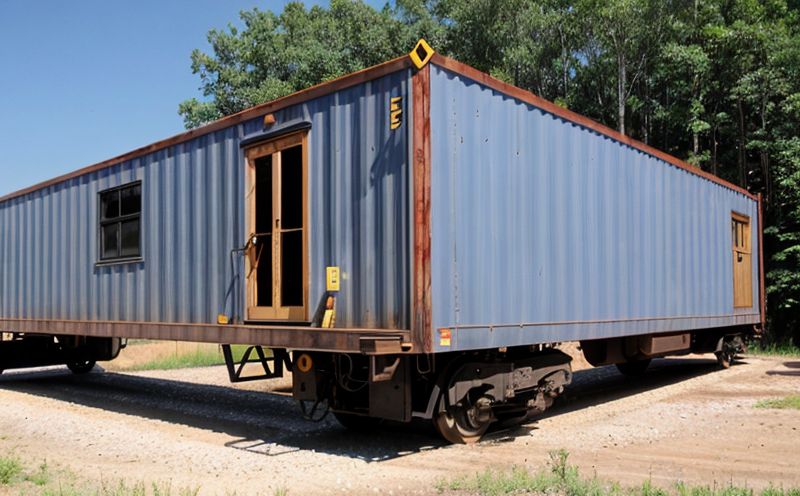Box railcar inspection
The inspection of box railcars is a critical process in ensuring the safe and efficient transport of goods across various industries. Box railcars are used extensively in transportation and logistics, serving as essential containers for freight such as food products, electronics, pharmaceuticals, and other valuable commodities.
These railcars are subject to rigorous inspection processes due to their role in transporting sensitive materials and high-value cargo. The primary objective of box railcar inspections is to ensure that these vehicles meet all safety standards, comply with regulatory requirements, and perform optimally under operational conditions. This service involves a detailed examination of the structural integrity, mechanical components, and environmental seals of the railcars.
The inspection process begins with an assessment of the external condition of the box railcar, including checking for any visible damage or wear that might affect its performance. Following this initial visual inspection, the interior is examined to ensure proper functioning of internal mechanisms such as doors, locks, and latches. Additionally, the integrity of the seals used in the railcar's design is evaluated to prevent leakage and contamination.
A key aspect of box railcar inspections involves compliance with international standards. Notably, ISO 18536:2021 provides guidelines for the construction and maintenance of railway wagons, including box railcars. This standard ensures that all components are fabricated using high-quality materials and assembled according to strict specifications.
The inspection process also includes a detailed examination of the mechanical components such as axles, wheels, brakes, and couplings. These elements must be in optimal condition to ensure safe operation on railway tracks. The use of advanced testing equipment, such as ultrasonic flaw detection systems and magnetic particle inspection tools, allows for precise evaluation of these components.
Environmental seals are crucial for maintaining the integrity of the cargo during transit. These seals prevent unauthorized access and protect against contamination or damage from the environment. Regular inspections ensure that these seals remain effective throughout the lifecycle of the railcar.
The results of box railcar inspections are meticulously documented, providing a comprehensive report detailing all findings and recommendations for necessary repairs or adjustments. This documentation serves as an essential tool for quality managers and compliance officers responsible for ensuring operational efficiency and regulatory adherence within their organizations.
Applied Standards
| Standard Name | Description |
|---|---|
| ISO 18536:2021 | This international standard provides guidelines for the construction and maintenance of railway wagons, including box railcars. It ensures that all components are fabricated using high-quality materials and assembled according to strict specifications. |
| ASTM E746-19 | ASTM E746-19 outlines procedures for nondestructive testing of welds in steel pressure vessels, which is applicable to the inspection of box railcars' structural components. This standard ensures that all welds are free from defects and meet specified quality criteria. |
| EN 15085:2014 | This European standard specifies requirements for welding in railway vehicles, including box railcars. It guarantees that the welding processes used adhere to best practices and produce structurally sound components. |
Benefits
- Ensures compliance with international safety standards (ISO 18536:2021, ASTM E746-19, EN 15085:2014).
- Reduces the risk of accidents and cargo damage during transit.
- Extends the operational life of box railcars by identifying potential issues early on.
- Maintains regulatory compliance, avoiding costly penalties or legal actions.
- Enhances customer satisfaction by ensuring product integrity and quality throughout transportation.
- Improves efficiency within supply chains through reliable performance and reduced downtime.
- Promotes sustainability by minimizing waste from premature failures of railcars.
Competitive Advantage and Market Impact
Effective box railcar inspections provide significant competitive advantages in the transportation and logistics industry. By ensuring that all box railcars meet stringent safety standards, organizations can enhance their reputation for reliability and excellence. This, in turn, attracts more clients and strengthens partnerships with key stakeholders.
The ability to consistently deliver safe and efficient transportation services contributes to lower operational costs due to reduced incidents and maintenance requirements. Additionally, adherence to international standards demonstrates a commitment to quality and safety, which is increasingly becoming a differentiating factor in the competitive market.
From a broader perspective, reliable box railcar inspections contribute positively to the overall efficiency of supply chains. By minimizing disruptions caused by failures or accidents, these inspections support smoother operations across industries reliant on efficient transportation networks. This not only benefits individual organizations but also has a positive ripple effect throughout the entire logistics ecosystem.
The market impact of effective box railcar inspections extends beyond individual companies to influence broader industry trends and practices. By setting high standards for safety and quality, these inspections encourage others within the sector to adopt similar approaches, ultimately raising the bar for all participants in the transportation and logistics industries.





